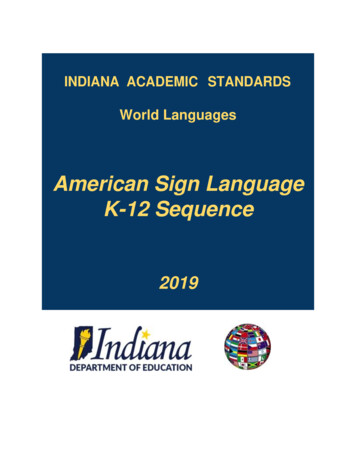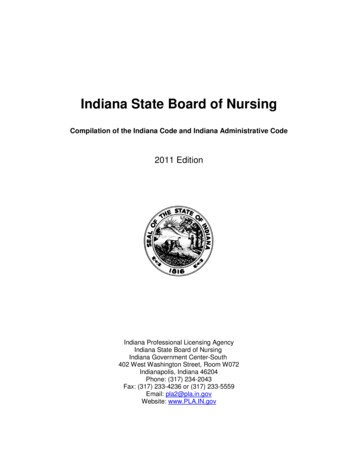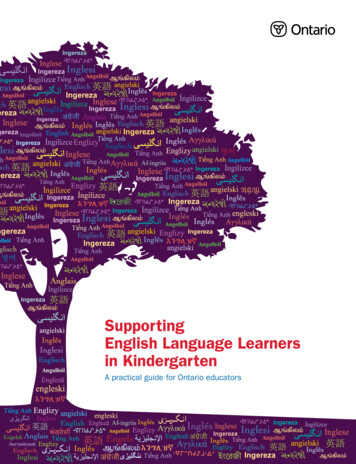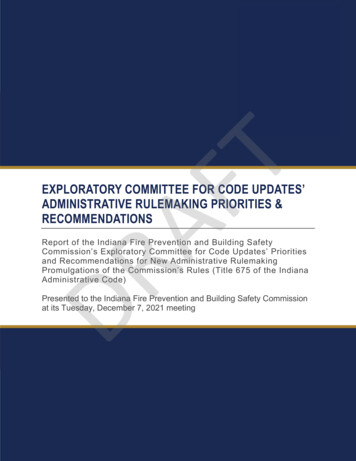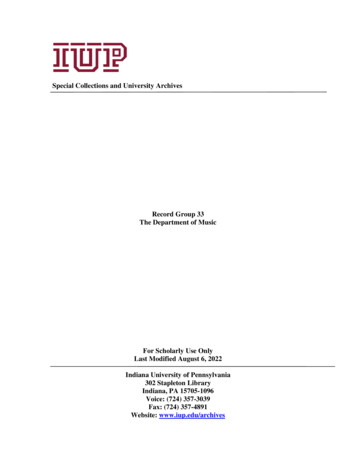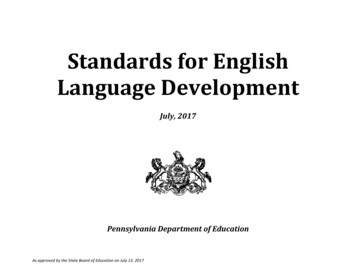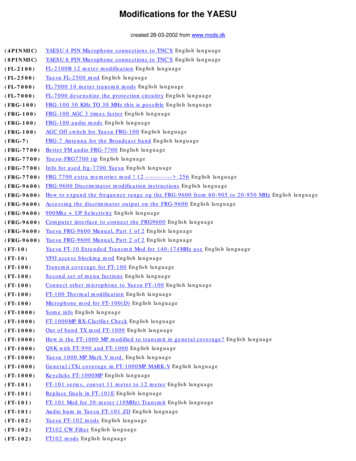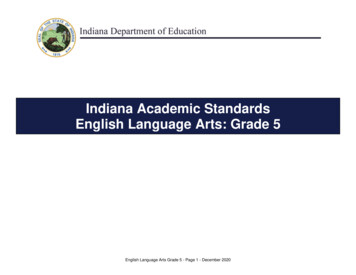
Transcription
Indiana Academic StandardsEnglish Language Arts: Grade 5English Language Arts Grade 5 - Page 1 - December 2020
IntroductionThe Indiana Academic Standards for English Language Arts are the result of a process designed to identify, evaluate, synthesize, and create the highest quality,rigorous standards for Indiana students. The standards are designed to ensure that all Indiana students, upon graduation, are prepared for both college and careeropportunities. In alignment with Indiana’s Every Student Succeeds Act (ESSA) plan, the academic standards reflect the core belief that all students can achieve ata high level.What are the Indiana Academic Standards?The Indiana Academic Standards are designed to help educators, parents, students, and community members understand what students need to know and beable to do at each grade level, and within each content strand, in order to exit high school college and career ready. The academic standards should form thebasis for strong Tier 1 instruction at each grade level and for each content area for all students, in alignment with Indiana’s vision for Multi-Tiered Systems ofSupports (MTSS). While the standards have identified the academic content or skills that Indiana students need in order to be prepared for both college andcareer, they are not an exhaustive list. Students require a wide range of physical, social, and emotional supports in order to be successful. This leads to a secondcore belief outlined in Indiana’s ESSA plan that learning requires an emphasis on the whole child.While the standards may be used as the basis for curriculum, the Indiana Academic Standards are not a curriculum. Curricular tools, including textbooks, areselected by the district/school and adopted through the local school board. However, a strong standards-based approach to instruction is encouraged, as mostcurricula will not align perfectly with the Indiana Academic Standards. Additionally, attention should be given at the district and school level to the instructionalsequence of the standards as well as to the length of time needed to teach each standard. Every standard has a unique place in the continuum of learning omitting one will certainly create gaps - but each standard will not require the same amount of time and attention. A deep understanding of the vertical articulationof the standards will enable educators to make the best instructional decisions. The Indiana Academic Standards must also be complemented by robust, evidencebased instructional practices, geared to the development of the whole child. By utilizing well-chosen instructional practices, social-emotional competencies andemployability skills can be developed in conjunction with the content standards.AcknowledgmentsThe Indiana Academic Standards could not have been developed without the time, dedication, and expertise of Indiana’s K-12 teachers, higher educationprofessors, and other representatives. We wish to specially acknowledge the committee members who dedicated many hours to the review and evaluation ofthese standards designed to prepare Indiana students for college and careers.English Language Arts Grade 5 - Page 2 - December 2020
English Language Arts: Grade 5READINGGuiding Principle: Students read a wide range of fiction, nonfiction, classic, and contemporary works, to build an understanding of texts,of themselves, and of the cultures of the United States and the world; to acquire new information; to respond to the needs and demandsof society and the workplace. Students apply a wide range of strategies to comprehend, interpret, evaluate, and appreciate texts. Theyread a wide range of literature in many genres from a variety of time periods and cultures from around the world to build anunderstanding of the many dimensions (e.g., philosophical, ethical, aesthetic) of human experience. They draw on their priorexperience, their interactions with other readers and writers, and reading skills that they have developed and refined.Reading: FoundationsThere are four key areas found in the Reading: Foundations section for grades K-5: Print Concepts, Phonological Awareness,Phonics, and Fluency. By demonstrating the skills listed in each section, students should be able to meet the Learning Outcome forReading: Foundations.Learning Outcome5.RF.1Apply foundational reading skills to build reading fluency and comprehension.Print Concepts5.RF.2.1Students are expected to build upon and continue applying concepts learned previously.K.RF.2.1 Demonstrate understanding that print moves from left to right across the page and from top to bottom.English Language Arts Grade 5 - Page 3 - December 2020
5.RF.2.2Students are expected to build upon and continue applying concepts learned previously.K.RF.2.2 Recognize that written words are made up of sequences of letters.5.RF.2.3Students are expected to build upon and continue applying concepts learned previously.1.RF.2.3 Recognize the components of a sentence (e.g., capitalization, first word, ending punctuation).5.RF.2.4Students are expected to build upon and continue applying concepts learned previously.1.RF.2.4 Learn and apply knowledge of alphabetical order.Phonological Awareness5.RF.3.1Students are expected to build upon and continue applying concepts learned previously.1.RF.3.1 Identify and produce rhyming words.5.RF.3.2Students are expected to build upon and continue applying concepts learned previously.1.RF.3.2 Blend sounds, including consonant blends, to produce single- and multi-syllable words.5.RF.3.3Students are expected to build upon and continue applying concepts learned previously.1.RF.3.3 Add, delete, or substitute sounds to change single-syllable words.5.RF.3.4Students are expected to build upon and continue applying concepts learned previously.1.RF.3.4 Distinguish beginning, middle (medial), and final sounds in single-syllable words5.RF.3.5Students are expected to build upon and continue applying concepts learned previously.1.RF.3.5 Segment the individual sounds in one-syllable words.English Language Arts Grade 5 - Page 4 - December 2020
Phonics5.RF.4.1Students are expected to build upon and continue applying concepts learned previously.1.RF.4.1 Use letter-sound knowledge of single consonants (hard and soft sounds), short and long vowels, consonantblends and digraphs, vowel teams (e.g., ai) and digraphs, and r-controlled vowels to decode phonetically regular words(e.g., cat, go, black, boat, her), independent of context.5.RF.4.2Students are expected to build upon and continue applying concepts learned previously.4.RF.4.2 Use the six major syllable patterns (CVC, CVr, V, VV, VCe, Cle) to read unknown words.5.RF.4.3Students are expected to build upon and continue applying concepts learned previously.2.RF.4.3 Apply knowledge of short and long vowels (including vowel teams) when reading regularly spelled one-syllablewords.5.RF.4.4Students are expected to build upon and continue applying concepts learned previously.3.RF.4.4 Read grade-appropriate words that have blends (e.g., walk, play) and common spelling patterns (e.g., qu- ;doubling the consonant and adding –ing, such as cut/cutting; changing the ending of a word from –y to –ies to make aplural).5.RF.4.5Students are expected to build upon and continue applying concepts learned previously.3.RF.4.5 Know and use more difficult word families when reading unfamiliar words (e.g., -ight).5.RF.4.6Use knowledge of all letter-sound correspondences, syllabication patterns, and morphology (e.g., roots and affixes) toread accurately unfamiliar multisyllabic words in context.Further guidance for support will be provided in the Literacy Framework.FluencyEnglish Language Arts Grade 5 - Page 5 - December 2020
5.RF.5Orally read grade-level appropriate or higher texts smoothly and accurately, with expression that connotescomprehension at the independent level.English Language Arts Grade 5 - Page 6 - December 2020
Reading: LiteratureThere are three key areas found in the Reading: Literature section for grades K-5: Key Ideas and Textual Support, StructuralElements and Organization, and Synthesis and Connection of Ideas. By demonstrating the skills listed in each section, studentsshould be able to meet the Learning Outcome for Reading: Literature.Learning Outcome5.RL.1Read and comprehend a variety of literature within a range of complexity appropriate for grades 4-5. By the end ofgrade 5, students interact with texts proficiently and independently.Key Ideas and Textual Support5.RL.2.1Quote accurately from a text when explaining what a text says explicitly and when drawing inferences from the text.5.RL.2.2Determine the theme of a story, play, or poem from details in the text, including how characters respond to challengesor how the speaker in a poem reflects upon a topic; summarize the text.5.RL.2.3Describe two or more characters, settings, or events in a story or play, drawing on specific details in the text, and howthey impact the plot.5.RL.2.4Students are expected to build upon and continue applying concepts learned previously.2.RL.2.4 Make predictions about the content of text using prior knowledge of text features, explaining whether theywere confirmed or not confirmed and why.Structural Elements and OrganizationEnglish Language Arts Grade 5 - Page 7 - December 2020
5.RL.3.1Explain how a series of chapters, scenes, or stanzas fits together to provide the overall structure of a particular story,play, or poem.5.RL.3.2Describe how a narrator’s or speaker’s point of view influences how events are portrayed.Connection of Ideas5.RL.4.1Analyze how visual and multimedia presentations and representations can enhance the meaning of a text.5.RL.4.2Compare and contrast stories in the same genre on their approaches to similar themes and topics.English Language Arts Grade 5 - Page 8 - December 2020
Reading: NonfictionThere are three key areas found in the Reading: Nonfiction section for grades K-5: Key Ideas and Textual Support, StructuralElements and Organization, and Synthesis and Connection of Ideas. By demonstrating the skills listed in each section, studentsshould be able to meet the Learning Outcome for Reading: Nonfiction.Learning Outcome5.RN.1Read and comprehend a variety of nonfiction within a range of complexity appropriate for grades 4-5. By the end ofgrade 5, students interact with texts proficiently and independently.Key Ideas and Textual Support5.RN.2.1Quote accurately from a text when explaining what a text says explicitly and when drawing inferences from the text.5.RN.2.2Determine two or more main ideas of a text and explain how they are supported by key details; summarize the text.5.RN.2.3Explain the relationships or interactions between two or more individuals, events, ideas, or concepts in a historical,scientific, or technical text based on specific information in the text.Structural Elements and Organization5.RN.3.1Apply knowledge of text features in multiple print and digital sources to locate information, gain meaning from a text,or solve a problem.English Language Arts Grade 5 - Page 9 - December 2020
5.RN.3.2Compare and contrast the organizational structure of events, ideas, concepts, or information in two or more texts.5.RN.3.3Analyze multiple accounts of the same event or topic, noting important similarities and differences in the perspectivesthe accounts represent.Connection of Ideas5.RN.4.1Explain how an author uses reasons and evidence to support claims in a text, identifying which reasons and evidencesupport which claims.5.RN.4.2Combine information from several texts or digital sources on the same topic in order to demonstrate knowledge aboutthe subject.5.RN.4.3Standard begins at sixth grade.6.RN.4.3: Compare and contrast one author’s presentation of events with that of another.English Language Arts Grade 5 - Page 10 - December 2020
Reading:VocabularyThere are two key areas found in the Reading: Vocabulary section for grades K-5: Vocabulary Building and Vocabulary in Literatureand Nonfiction Texts. By demonstrating the skills listed in each section, students should be able to meet the Learning Outcome forReading: Vocabulary.Learning Outcome5.RV.1Build and use accurately general academic and content-specific words and phrases.Vocabulary Building5.RV.2.1Select and apply context clues (e.g., word, phrase, sentence, and paragraph clues) and text features to determine themeanings of unknown words.5.RV.2.2Identify relationships among words, including multiple meanings, synonyms and antonyms, homographs, metaphors,similes, and analogies.5.RV.2.3Standard begins at sixth grade.6.RV.2.3: Distinguish among the connotations of words with similar denotations.5.RV.2.4Apply knowledge of word structure elements, known words, and word patterns to determine meaning (e.g., wordorigins, common Greek and Latin affixes and roots, parts of speech).English Language Arts Grade 5 - Page 11 - December 2020
5.RV.2.5Consult reference materials, both print and digital (e.g., dictionary, thesaurus), to find the pronunciation and clarify theprecise meanings of words and phrases.Vocabulary in Literature and Nonfiction Texts5.RV.3.1Determine how words and phrases provide meaning to works of literature, including imagery, symbolism, andfigurative language (e.g., similes, metaphors, hyperbole, or allusion).5.RV.3.2Determine the meaning of general academic and content-specific words and phrases in a nonfiction text relevant to afifth grade topic or text.5.RV.3.3Analyze the meanings of proverbs, adages, and idioms in context.English Language Arts Grade 5 - Page 12 - December 2020
WRITINGGuiding Principle: Students employ a wide range of strategies as they write and use different writing process elements appropriately tocommunicate with different audiences for a variety of purposes. Students apply knowledge of language structure, languageconventions, media techniques, figurative language, and genre to create, critique, and discuss writing. Students conduct research onissues and interests by generating ideas and questions, and by posing problems. They gather, evaluate, and synthesize data from avariety of sources to communicate their discoveries in ways that suit their purpose and audience.WritingThere are five key areas found in the Writing section for grades K-5: Handwriting, Writing Genres, the Writing Process, the ResearchProcess, and Conventions of Standard English. By demonstrating the skills listed in each section, students should be able to meet theLearning Outcome for Writing.Learning Outcome5.W.1Write routinely over a variety of time frames and for a range of discipline-specific tasks, purposes, and audiences;apply reading standards to support reflection and response to literature and nonfiction texts.Handwriting5.W.2.1Students are expected to build upon and continue applying concepts learned previously.4.W.2.1 Write legibly in print or cursive, forming letters and words that can be read by others.5.W.2.2Students are expected to build upon and continue applying concepts learned previously.K.W.2.2 Write by moving from left to right and top to bottom.English Language Arts Grade 5 - Page 13 - December 2020
Writing Genres: Argumentative, Informative, and Narrative5.W.3.1Write persuasive compositions in a variety of forms that –a. Clearly present a position in an introductory statement to an identified audience.b. Support the position with qualitative and quantitative facts and details from various sources, including texts.c. Use an organizational structure to group related ideas that support the purpose.d. Use language appropriate for the identified audience.e. Connect reasons to the position using words, phrases, and clauses.f. Provide a concluding statement or section related to the position presented.5.W.3.2Write informative compositions on a variety of topics that a. Introduce a topic; organize sentences and paragraphs logically, using an organizational form that suits the topic.b. Employ sufficient examples, facts, quotations, or other information from various sources and text to give clearsupport for topics.c. Connect ideas within and across categories using transition words (e.g. therefore, in addition).d. Include text features (e.g. formatting, pictures, graphics) and multimedia when useful to aid comprehension.e. Use appropriate language, vocabulary, and sentence variety to convey meaning; for effect; and to support atone and formality appropriate to the topic and audience.f. Provide a concluding statement or section related to the information or explanation presented.5.W.3.3Write narrative compositions in a variety of forms that –a. Develop the exposition (e.g., describe the setting, establish the situation, introduce the narrator and/orcharacters).b. Develop an event sequence (e.g., conflict, climax, resolution) that unfolds naturally, connecting ideas and eventsusing transitions.c. Use narrative techniques, such as dialogue, description, and pacing to develop experiences and events or showthe responses of characters to situations.d. Use precise and expressive vocabulary and figurative language for effect.e. Provide an ending that follows from the narrated experiences or events.English Language Arts Grade 5 - Page 14 - December 2020
The Writing Process5.W.4Apply the writing process to –a. Generate a draft by developing, selecting and organizing ideas relevant to topic, purpose, and genre; revise toimprove writing, using appropriate reference materials (e.g., quality of ideas, organization, sentence fluency,word choice); and edit writing for format and standard English conventions.b. Use technology to interact and collaborate with others to publish legible documents.The Research Process: Finding, Assessing, Synthesizing, and Reporting Information5.W.5Conduct short research assignments and tasks on a topic.a. With support, formulate a research question (e.g., What were John Wooden’s greatest contributions to collegebasketball?).b. Identify and acquire information through reliable primary and secondary sources.c. Summarize and paraphrase important ideas and supporting details, and include direct quotations whereappropriate, citing the source of information.d. Avoid plagiarism and follow copyright guidelines for use of images, pictures, etc.e. Present the research information, choosing from a variety of sources.Conventions of Standard English: Grammar and Usage / Capitalization, Punctuation, and Spelling5.W.6.1Demonstrate command of English grammar and usage, focusing on:5.W.6.1a Nouns/Pronouns – Students are expected to build upon and continue applying conventions learnedpreviously. 4.W.6.1a Nouns/Pronouns – Writing sentences that include relative pronouns (e.g., who, which) andreflexive pronouns (e.g., myself, ourselves) and explaining their functions in the sentence.5.W.6.1b Verbs –a. Writing sentences that use the perfect (e.g., I have walked, I had walked, I will have walked) verb tenses.b. Correctly using verbs that are often misused (e.g., lie/lay, sit/set, rise/raise).English Language Arts Grade 5 - Page 15 - December 2020
5.W.6.1c Adjectives/ Adverbs –Students are expected to build upon and continue applying conventions learnedpreviously. 4.W.6.1c Adjectives/ Adverbs –Writing sentences using relative adverbs (e.g., where, when) and explainingtheir functions in the sentence.5.W.6.1d Prepositions – Writing sentences that include prepositional phrases and explaining their functions in thesentence.5.W.6.1e Usage – Writing correctly simple, compound, and complex declarative, interrogative, imperative, andexclamatory sentences, using correlative conjunctions (e.g., either/or, neither/nor).5.W.6.2Demonstrate command of capitalization, punctuation, and spelling, focusing on:5.W.6.2a Capitalization – Applying correct usage of capitalization in writing.5.W.6.2b Punctuation –a. Applying correct usage of apostrophes and quotation marks in writing.b. Using a comma for appositives, to set off the words yes and no, to set off a tag question from the rest of thesentence, and to indicate direct address.5.W.6.2c Spelling – Applying correct spelling patterns and generalizations in writing.English Language Arts Grade 5 - Page 16 - December 2020
SPEAKING AND LISTENINGGuiding Principle: Students listen actively and communicate effectively for a variety of purposes, including for learning, enjoyment,persuasion, and the exchange of information and ideas. Students adjust their use of language to communicate effectively with a varietyof audiences and for different purposes. Students develop an understanding of and respect for diversity in language use, patterns, anddialects.Speaking and ListeningThere are three key areas found in the Speaking and Listening section for grades K-5: Discussion and Collaboration, Comprehension,and Presentation of Knowledge and Ideas. By demonstrating the skills listed in each section, students should be able to meet theLearning Outcome for Speaking and Listening.Learning Outcome5.SL.1Listen actively and adjust the use of spoken language (e.g., conventions, style, vocabulary) to communicate effectivelywith a variety of audiences and for different purposes.Discussion and Collaboration5.SL.2.1Engage effectively in a range of collaborative discussions (one-on-one, in groups, and teacher-led) on gradeappropriate topics and texts, building on others’ ideas and expressing personal ideas clearly.5.SL.2.2Reflect on and contribute to ideas under discussion by drawing on readings and other resources.English Language Arts Grade 5 - Page 17 - December 2020
5.SL.2.3Establish and follow agreed-upon rules for discussion.5.SL.2.4Pose and respond to specific questions by making comments that contribute to the discussion and elaborate on theremarks of others.5.SL.2.5Review the key ideas expressed and draw conclusions in reference to information and knowledge gained from thediscussions.Comprehension5.SL.3.1Orally summarize or respond to a written text read aloud or information presented in diverse media and formats,including visually, quantitatively, and orally.5.SL.3.2Summarize a speaker’s points as they relate to main ideas or supporting details and demonstrate how claims aresupported by reasons and evidence.Presentation of Knowledge and Ideas5.SL.4.1Using appropriate language, present information on a topic or text, narrative, or opinion in an organized manner, witheffective introductions and conclusions, using appropriate structure, appropriate facts and relevant, descriptive detailsto support main ideas or themes; speak clearly and concisely at an understandable pace.5.SL.4.2Create engaging presentations that include multimedia components and visual displays when appropriate to enhancethe development of main ideas or themes.English Language Arts Grade 5 - Page 18 - December 2020
5.SL.4.3Students are expected to build upon and continue applying conventions learned previously.2.SL.4.3 Give and follow multi-step directions.English Language Arts Grade 5 - Page 19 - December 2020
MEDIA LITERACYGuiding Principle: Students develop critical thinking about the messages received and created by media. Students recognize that mediaare a part of culture and function as agents of socialization and develop understanding that people use individual skills, beliefs, andexperiences to construct their own meanings from media messages. Students develop media literacy skills in order to become moreinformed, reflective, and engaged participants in society.Media LiteracyBy demonstrating the skills listed in Media Literacy, students should be able to meet the Learning Outcome for Media Literacy.Learning Outcome5.ML.1Identify how information found in electronic, print, and mass media is used to inform, persuade, entertain, andtransmit culture.Media Literacy5.ML.2.1Review claims made in various types of media and evaluate evidence used to support these claims.5.ML.2.2Identify the role of the media in focusing people’s attention on events and in forming their opinions on issues.English Language Arts Grade 5 - Page 20 - December 2020
English Language Arts Grade 5 - Page 1 - December 2020 Indiana Academic Standards English Language Arts: Grade 5 . and within each content strand, in order to exit high school college and career ready. The academic standards should form the . they impact the plot. 5.RL.2.4
